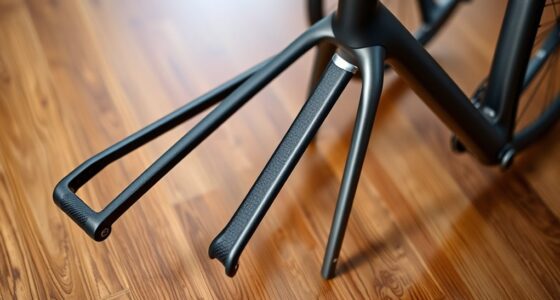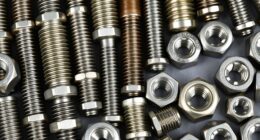Carbon fiber bicycles offer lightweight strength, improving handling, speed, and customization for a sleek look. They provide excellent performance but can be prone to damage like cracks or delamination from impacts. Proper care involves regular inspections, gentle cleaning, and avoiding impacts. Repairing damage can be costly, so knowing when to replace the frame is key for safety and performance. Stick with good maintenance habits to keep your bike in top shape, and you’ll find plenty more tips ahead.
Key Takeaways
- Carbon fiber bikes are lightweight, strong, and enhance handling, making them ideal for high performance and racing applications.
- They are susceptible to cracks, impact damage, and delamination, requiring careful inspection and professional repairs.
- Proper maintenance includes gentle cleaning and storage to prevent surface damage and prolong frame lifespan.
- Repair costs can be high, and significant damage may necessitate frame replacement for safety and performance.
- Recycling carbon fiber is challenging, raising environmental concerns despite its performance benefits.
Advantages of Carbon Fiber Frames
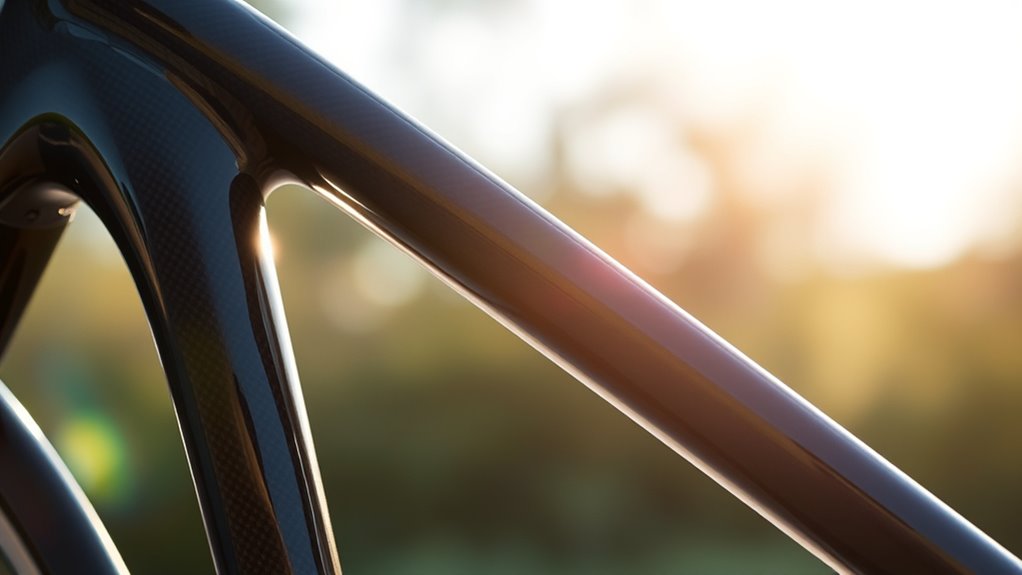
One of the main reasons cyclists choose carbon fiber frames is their exceptional strength-to-weight ratio. This allows you to enjoy a lightweight bike that doesn’t sacrifice durability. Material innovation has led to advanced manufacturing techniques, giving you stronger, more resilient frames. Plus, carbon fiber offers impressive aesthetic customization options, so you can personalize your bike’s look with unique colors, textures, and finishes. These features make your ride more comfortable and efficient. Moreover, embracing failure in the development process has driven improvements in carbon fiber technology, resulting in even more durable and innovative frames. As a result, manufacturers continuously refine their methods to deliver high-performance materials that meet the demands of serious cyclists. Additionally, understanding cultural intelligence can help companies better tailor their marketing and product development strategies to diverse global markets. Furthermore, ongoing research in material science contributes to the continuous evolution of carbon fiber technologies, ensuring that future bike frames will be even more efficient and durable. A key aspect of this evolution is the integration of emerging technologies, which can accelerate innovation and enhance manufacturing processes.
Common Drawbacks of Carbon Fiber Bicycles

Despite their many advantages, carbon fiber bicycles come with some notable drawbacks that you should consider. One major issue is material recycling; carbon fiber is difficult and costly to recycle, which raises environmental concerns. When a bike reaches the end of its life, disposing of it can contribute to environmental impact because most components aren’t biodegradable and require specialized processes. Additionally, carbon fiber is more susceptible to damage from impacts or crashes, often leading to expensive repairs or replacements. Unlike metal frames, cracks or fractures in carbon fiber are harder to detect and can compromise safety. Furthermore, the fragility of carbon fiber means that it may not be suitable for all riding conditions or for riders prone to accidents. These drawbacks highlight the importance of weighing environmental considerations and durability when choosing a carbon fiber bike. While lightweight and strong, its environmental footprint and repair challenges are significant factors to keep in mind. Also, the material properties of carbon fiber contribute to its susceptibility to impact damage, necessitating careful handling and maintenance. Moreover, the difficulty in repair of damaged carbon fiber frames can make fixing issues more complex and costly compared to traditional materials. Proper maintenance practices are essential to prolong the lifespan of the bike and prevent unexpected failures.
Weight and Performance Benefits

You’ll notice that carbon fiber bikes are markedly lighter, making them easier to handle and carry. This lightweight design helps you accelerate faster and maintain higher speeds with less effort. Additionally, the organic and natural juices used in various health routines can enhance your overall well-being and support your fitness goals. Plus, improved handling gives you better control, especially on challenging terrain, and the material’s durability ensures that your bike remains resilient over time. Regular inspection of the suspension system can help maintain optimal performance and safety, prolonging the lifespan of your carbon fiber bicycle. To further optimize performance, paying attention to tuning options such as proper tire pressure and drivetrain adjustments can make a significant difference in your ride quality. Proper maintenance, such as checking the tire pressure regularly and inspecting for cracks, can further prolong the lifespan of your carbon fiber bicycle.
Lightweight Design Advantages
Have you ever wondered how a bicycle can feel so responsive and easy to handle? The secret lies in its lightweight design, made possible by carbon fiber. This material allows you to reduce weight without sacrificing strength, enhancing overall performance.
A lighter bike means quicker acceleration, easier climbing, and better maneuverability. Plus, carbon fiber bikes offer aesthetic customization, letting you choose sleek finishes and personalized designs. Moreover, the use of carbon fiber supports material recycling, making it an eco-friendly choice. With these benefits, your ride feels more agile and efficient, transforming your cycling experience.
Furthermore, the lightweight design can contribute to self-custody and better compliance with regulations, ensuring you maintain control over your bike’s components and adhere to safety standards. Incorporating sustainable materials into manufacturing processes aligns with environmentally conscious cycling practices, supporting long-term ecological benefits.
In addition, manufacturers are increasingly adopting eco-friendly production methods, reducing the environmental impact of creating lightweight frames. This approach not only benefits the environment but also demonstrates a commitment to industry sustainability. Additionally, advances in carbon fiber manufacturing techniques enhance durability while maintaining lightness, further benefiting consumers. Whether you’re racing or commuting, the lightweight design of carbon fiber bicycles gives you a noticeable edge in handling and performance.
Enhanced Speed and Agility
Because carbon fiber is incredibly lightweight yet strong, it markedly boosts a bicycle’s speed and agility. Its aerodynamic advantages reduce drag, allowing you to cut through air more efficiently and accelerate faster. The lightweight frame means less effort is needed to maintain high speeds, giving you an edge in racing performance. You’ll notice quicker response when you pedal and sharper handling on tight corners. Carbon fiber’s stiffness transfers power directly from your legs to the wheels, maximizing every push. This combination of reduced weight and enhanced aerodynamics results in a bike that feels agile and responsive, especially during sprints or climbs. Additionally, understanding the weight of the bike is crucial for proper handling and transportation. Moreover, the material properties of carbon fiber contribute to its durability and resistance to fatigue, ensuring the bike maintains optimal performance over time. The manufacturing processes, such as vacuum technology, play a significant role in achieving precise fiber layup and overall quality, which is essential for high-performance bicycles. Recognizing the cost factors involved in manufacturing these components can help you appreciate their quality and craftsmanship, especially when considering vacuum technology used in manufacturing to achieve precise fiber layup.
Improved Handling Performance
The use of carbon fiber markedly enhances handling performance by reducing weight without compromising strength. This lighter frame allows you to maneuver more easily, improving your tire grip and steering precision.
As a result, you’ll experience sharper turns and more control on challenging terrains. The reduced weight also means less effort to accelerate and brake, making your ride more responsive overall.
Carbon fiber’s stiffness helps maintain stability during high-speed descents and tight corners. You’ll notice quicker, more accurate steering inputs, especially in technical sections.
To maximize these benefits, consider these key points:
- Less weight improves tire grip in corners
- Enhanced stiffness boosts steering precision
- Lighter bikes respond faster to rider input
- Better handling increases confidence on diverse terrain
Durability and Impact Resistance
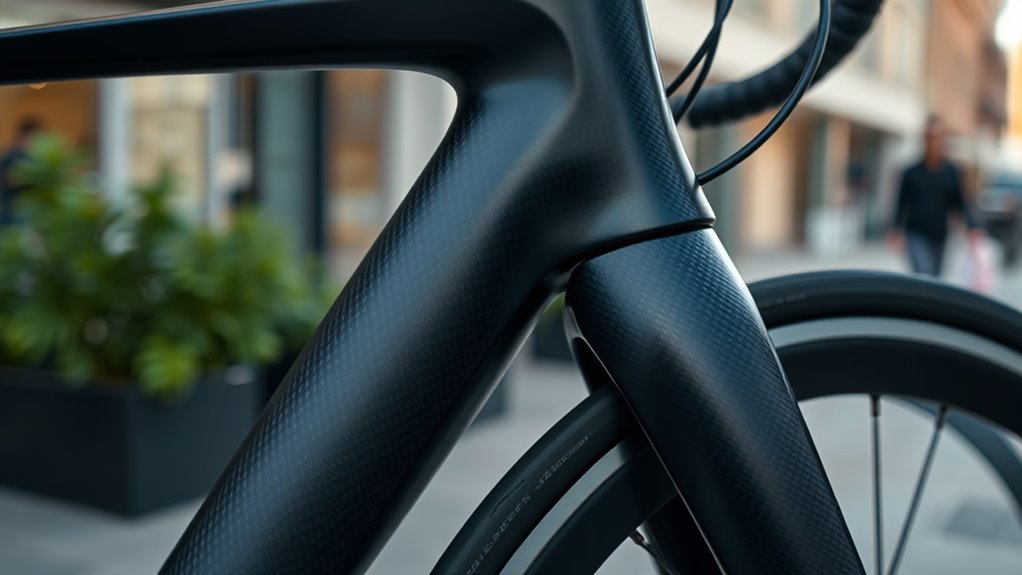
Carbon fiber offers impressive strength and a bit of flexibility, helping your bike withstand impacts without breaking. Its ability to absorb shocks means fewer cracks and damage over time.
If a crack does appear, you’ll want to know how to spot it early and whether repairs are possible.
Material Strength and Flexibility
While lightweight, carbon fiber offers exceptional strength and flexibility that enhance a bicycle’s durability and impact resistance. Its fiber elasticity allows the material to bend slightly under stress without cracking, contributing to long-lasting performance.
The high material stiffness ensures the frame maintains shape and efficiency during rides, even under heavy loads. You benefit from a balance of strength and flexibility that protects against impacts and reduces fatigue.
- Carbon fiber can be engineered for specific fiber elasticity, optimizing flexibility where needed
- Its high material stiffness provides a strong, stable ride
- The combination minimizes the risk of fractures over time
- Custom layups allow for tailored strength and flex properties, boosting durability
Impact Absorption Capabilities
Ever wondered how carbon fiber frames withstand impacts and rough terrain? Their impact absorption capabilities are impressive. Carbon fiber’s inherent shock absorption helps reduce the force transferred to you during bumps, providing a smoother ride. Its vibration damping properties also minimize fatigue by absorbing road buzz and chatter.
This material’s ability to dissipate energy ensures the frame remains resilient, even after repeated impacts. While not completely impact-proof, high-quality carbon fiber frames resist cracking and deformation better than many metals. Properly designed, they balance stiffness with flexibility, offering durability without sacrificing comfort.
Crack Detection and Repair
Understanding how your bike holds up over time means paying attention to crack detection and repair. Cracks in carbon fiber frames can compromise safety and performance if left unnoticed. Regular inspection helps identify damage early.
Look for surface scratches, discoloration, or fiber fraying. When you suspect a crack, consider these repair techniques:
- Visual inspection for visible cracks or damage
- Tap testing to locate delaminations
- Ultrasonic or x-ray scans for internal damage
- Professional repairs for structural cracks, including epoxy infusion or patching
Addressing cracks promptly ensures your bike maintains its durability and impact resistance. Never ignore signs of damage—early crack detection and proper repair extend your bike’s lifespan and keep you safe on every ride.
Design Flexibility and Customization Options
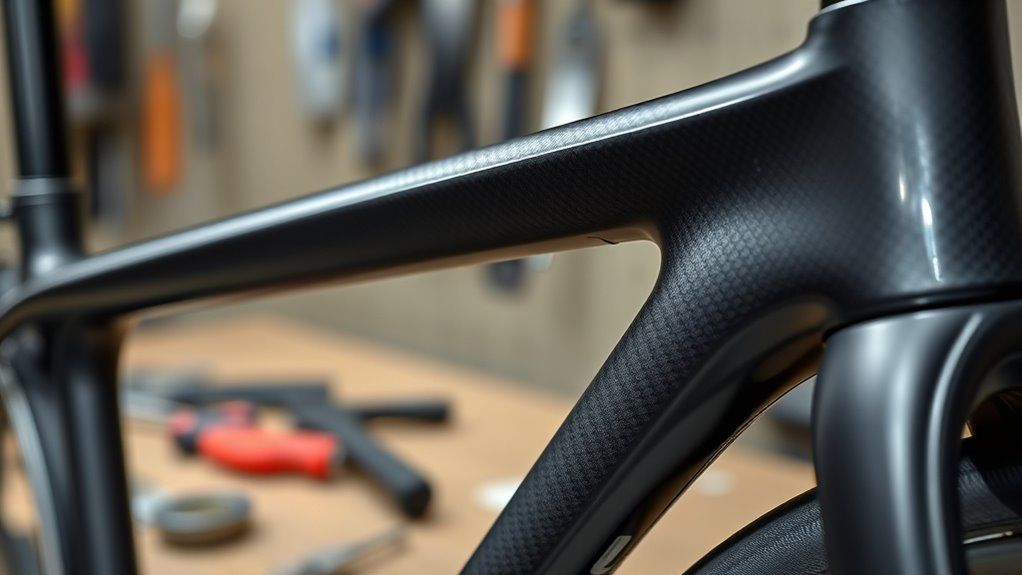
Have you ever wondered how carbon fiber allows for greater design flexibility in bicycle manufacturing? This material’s unique properties enable you to create frames with sleek, aerodynamic shapes that were impossible with traditional materials.
Carbon fiber’s aesthetic versatility means you can customize your bike’s appearance, from bold color schemes to intricate patterns, making your ride truly one-of-a-kind.
Its design customization options let you choose specific tube profiles and geometries tailored to your riding style, all while maintaining strength and lightweight performance.
Manufacturers can push the boundaries of innovation, offering personalized frames that match your preferences. With carbon fiber, you’re not limited by standard design constraints—your bike can be as functional as it’s visually striking, reflecting your individual style and needs.
Cost Considerations and Value
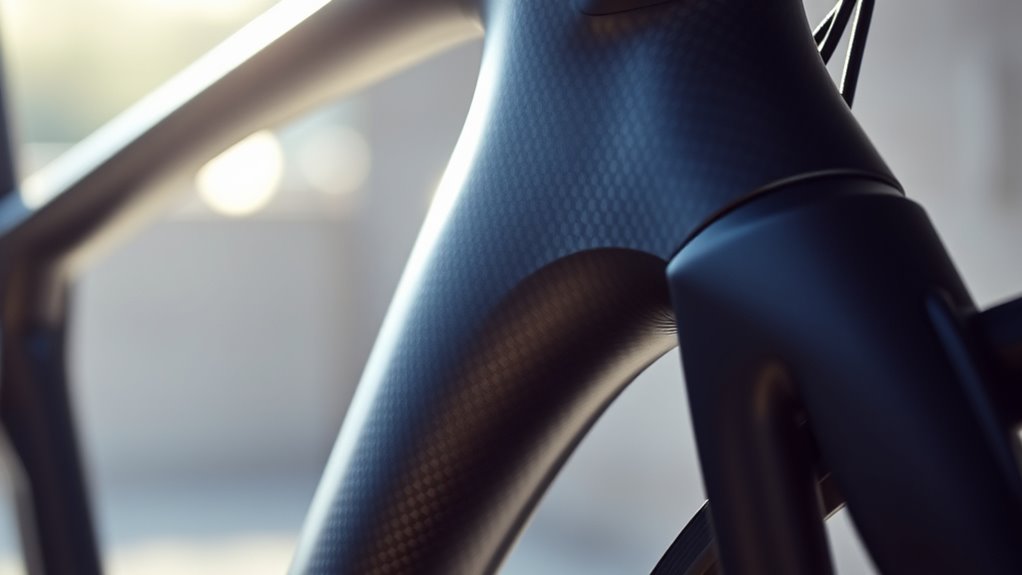
Considering the higher manufacturing costs of carbon fiber, it’s natural to question whether its benefits justify the investment. When you compare prices, carbon fiber bikes tend to be more expensive upfront, but they often deliver better performance and weight savings.
Carbon fiber bikes cost more upfront but offer superior performance and weight savings.
Think about resale value—carbon fiber bikes usually hold their worth well, especially if maintained properly. To evaluate worth, consider these points:
- Price comparison with aluminum or steel bikes
- Longevity and durability reducing replacement costs
- Performance gains that justify the initial expense
- Resale value after years of use
While the initial cost is higher, the long-term benefits and retention of value can make carbon fiber a worthwhile investment if you prioritize performance and durability.
Maintenance and Care for Carbon Fiber Bikes
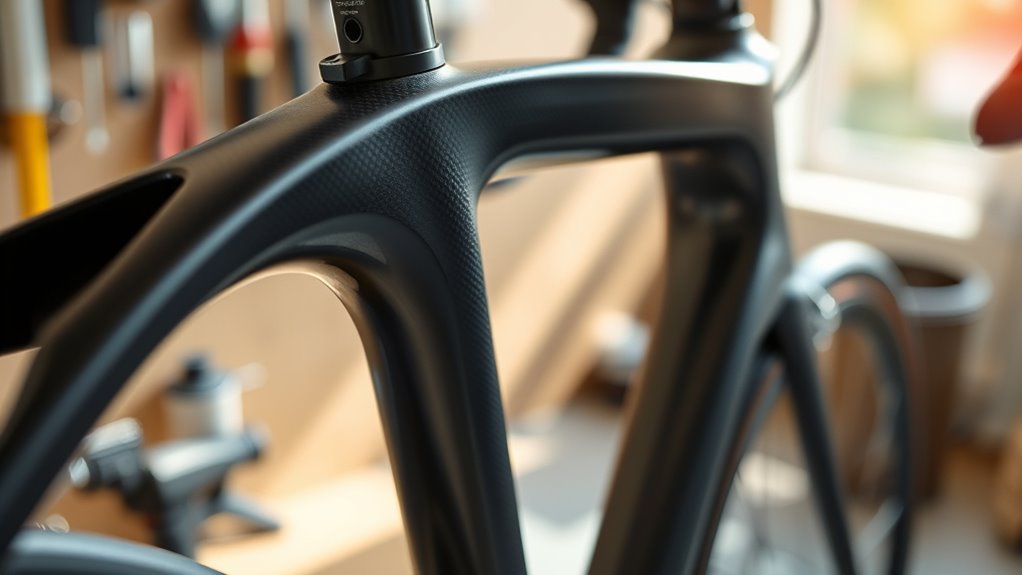
Proper maintenance is essential to keep your carbon fiber bike performing at its best and to protect its lightweight structure. Regular cleaning prevents dirt and grime buildup, which can cause abrasions. Use gentle cleaning tips, like a soft brush and mild soap, to avoid damaging the surface. When inspecting your bike, ensure component compatibility—using parts designed for carbon fiber frames helps prevent stress points. Avoid high-pressure washing, as it may induce cracks. Store your bike in a dry, shaded area to prevent UV damage. Here’s a quick guide:
| Maintenance Step | Tips |
|---|---|
| Cleaning | Use soft brushes, mild soap |
| Inspection | Check for cracks, loose parts |
| Component Compatibility | Use compatible, recommended parts |
| Storage | Keep away from UV, moisture |
| Repairs | Seek professional help when needed |
Repairability and Long-Term Durability
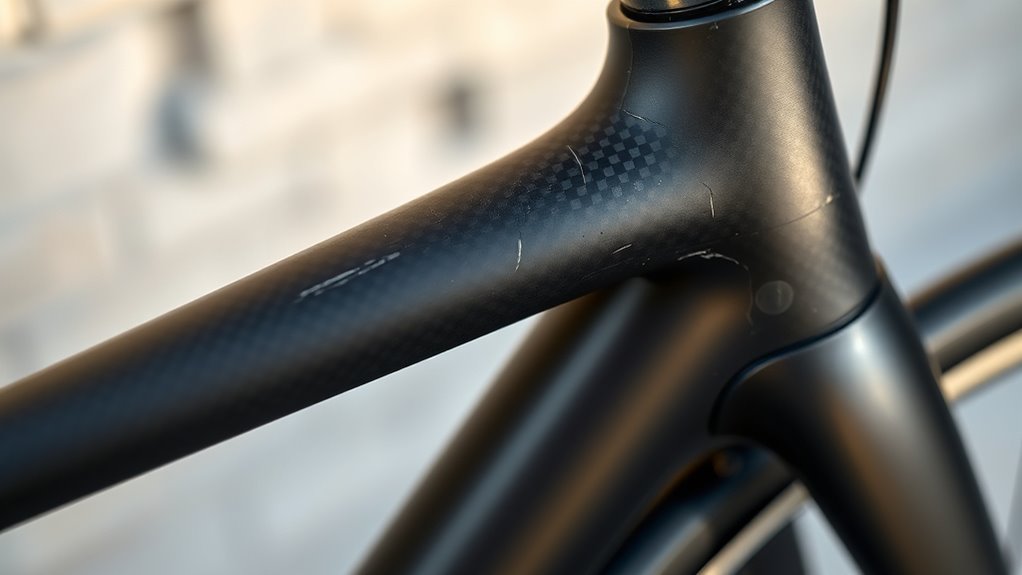
While carbon fiber bikes are renowned for their lightweight strength, their repairability and long-term durability depend on proper care and understanding their limitations.
If you experience damage, frame repair can be complex and costly, often requiring specialized skills and equipment.
Long-term durability is influenced by how well you protect your bike from impacts and stress.
Keep in mind:
- Minor cracks may be repairable, but extensive damage often means replacing the frame
- Repairing carbon fiber requires professional expertise to restore strength
- Regular inspections help identify issues before they worsen
- Over time, impacts can weaken the structure, reducing durability
Understanding these factors ensures you manage your bike’s longevity effectively, but always weigh repair costs against replacing the frame to maintain safety and performance.
Best Practices for Preventing Damage
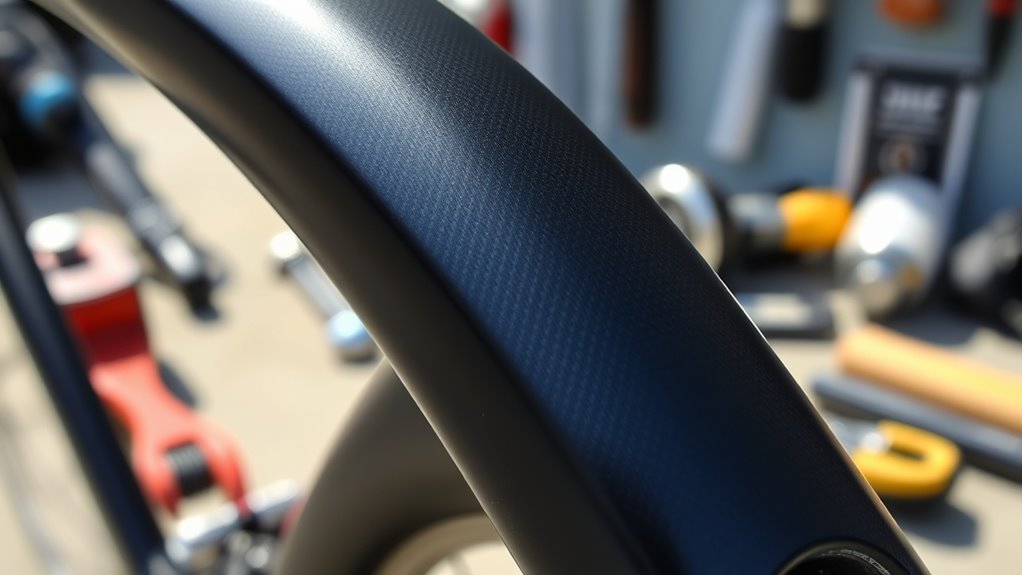
To keep your carbon fiber bike in top shape, you should follow simple best practices. Regular inspections help catch issues early.
Proper storage prevents unnecessary stress on the frame.
Additionally, riding mindfully reduces the risk of impact damage and preserves your bike’s integrity.
Regular Inspection Routines
Regularly inspecting your bicycle’s carbon fiber components is vital for catching damage early and preventing costly repairs or failures. Focus on frame inspection to identify any signs of stress or impact. Crack monitoring is essential—look for tiny fractures or delamination that mightn’t be immediately obvious.
Conduct a visual check after each ride, paying close attention to high-stress areas like joints and tubing. Keep an eye out for discoloration or surface irregularities that could indicate damage. Confirm your inspection routine includes gently feeling for soft spots or irregular textures.
Regular checks help you catch issues before they worsen, maintaining your bike’s integrity and safety. Incorporate these practices into your maintenance to extend the lifespan of your carbon fiber bicycle.
Proper Storage Techniques
Proper storage is essential for maintaining your bicycle’s carbon fiber integrity and preventing damage over time. To guarantee storage safety, keep your bike in a climate-controlled environment, away from extreme temperatures and humidity. Avoid leaving it in direct sunlight or damp areas, which can weaken the material. Use a sturdy bike stand or wall mounts to prevent accidental falls or pressure points. Consider the table below for ideal storage tips:
| Storage Location | Climate Control | Safety Precautions |
|---|---|---|
| Indoors | Keep dry and cool | Avoid sharp impacts |
| Garage | Ventilation | Secure bike properly |
| Closet | Stable temperature | Keep away from chemicals |
Following these best practices helps preserve your bike’s performance and prolongs its lifespan.
Mindful Riding Habits
Since your bike’s carbon fiber frame is sensitive to impacts and stress, adopting mindful riding habits is key to preventing damage. Focus on smooth, controlled movements to reduce stress on the frame, preserving its aesthetic appeal.
Maintain proper riding posture to enhance ergonomic comfort and avoid unnecessary strain. Be cautious on rough terrain by choosing smoother paths or lowering your speed to prevent sudden impacts.
Regularly check your bike’s alignment and tire pressure, ensuring ideal handling and reducing the risk of stress fractures. Practicing these habits not only protects your investment but also enhances your riding experience, keeping your bike looking sleek and performing well longer.
Mindful riding ultimately prolongs the life of your carbon fiber frame and maintains its visual appeal.
When to Consider Upgrading or Replacing Your Frame

Knowing when to upgrade or replace your bicycle frame is vital to guarantee safety and performance. If you notice cracks, significant dents, or persistent frame damage, it’s time to consider replacements.
Changes in your riding style or increased performance needs might also warrant an upgrade, especially if your current frame material selection no longer matches your goals. For carbon fiber frames, delamination or visible fiber damage signals deterioration.
Upgrading considerations include weight reduction, improved aerodynamics, or enhanced durability. Keep in mind that even minor damage can compromise safety, so regular inspections are key.
When in doubt, consult a professional for thorough assessment. Upgrading at the right time ensures your bike continues to serve you well while maintaining top safety standards.
Frequently Asked Questions
How Can I Identify Genuine Carbon Fiber Frames?
To identify genuine carbon fiber frames, check the fiber quality and construction. You should notice a smooth, glossy finish without bubbles or uneven layers.
Examine the frame branding for authenticity; reputable brands typically have clear, precise markings.
Also, consider the weight—genuine carbon fiber frames are lightweight but sturdy.
Finally, consult the seller or manufacturer’s specifications to confirm the frame’s material and verify it matches the expected standards for quality.
Are Carbon Fiber Bikes Suitable for All Riding Styles?
You might wonder if carbon fiber bikes suit all riding styles. They excel in providing excellent frame durability and riding comfort, making them versatile for various disciplines.
Whether you’re into racing, mountain biking, or casual rides, carbon fiber frames can adapt well. However, consider your riding environment and style—while they offer smooth performance, some riders prefer alternatives for specific terrains or heavy-duty use.
What Are the Environmental Impacts of Carbon Fiber Production?
You might wonder about the environmental impacts of carbon fiber production. It’s important to know that producing carbon fiber involves energy-intensive processes, which can contribute to pollution.
However, sustainable manufacturing practices are emerging to reduce these effects. Additionally, eco-friendly disposal methods are being developed to recycle or safely dispose of carbon fiber waste.
Can Carbon Fiber Frames Be Recycled?
Recycling carbon fiber frames can feel like chasing a rainbow—difficult but worth the effort. While traditional recycling methods exist, they’re complex and not widely available yet.
However, eco-friendly alternatives like repurposing or creating new composites are emerging. You can help reduce waste by choosing bikes with recyclable materials or supporting innovations in recycling methods.
Turning your ride into a symbol of sustainability and hope for a cleaner planet.
How Do I Choose the Right Maintenance Products for Carbon Fiber?
When choosing maintenance products for your carbon fiber bike, you need to focus on product compatibility and your maintenance routines.
Always opt for gentle, pH-neutral cleaners specifically designed for carbon fiber to prevent damage. Avoid harsh chemicals or abrasive materials.
Regularly inspect your bike, and use soft cloths or sponges during cleaning. This way, you protect your frame while keeping it in top condition, ensuring longevity and performance.
Conclusion
Choosing a carbon fiber bike is like riding on a cloud—light, sleek, and exhilarating. With proper care, your ride can stay smooth and swift for years, weathering the bumps of the road like a seasoned dancer. Just remember, a little maintenance keeps your masterpiece shining bright. When the time comes to upgrade, you’ll know it’s time to turn the page and embrace new adventures, riding confidently into the horizon’s endless possibilities.




